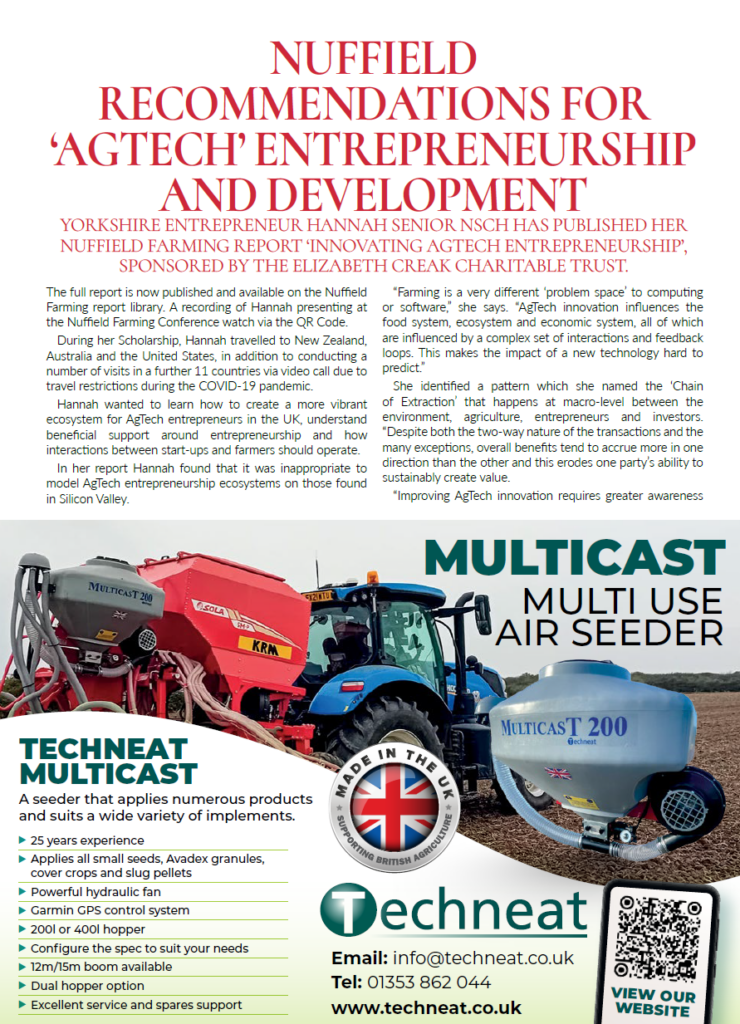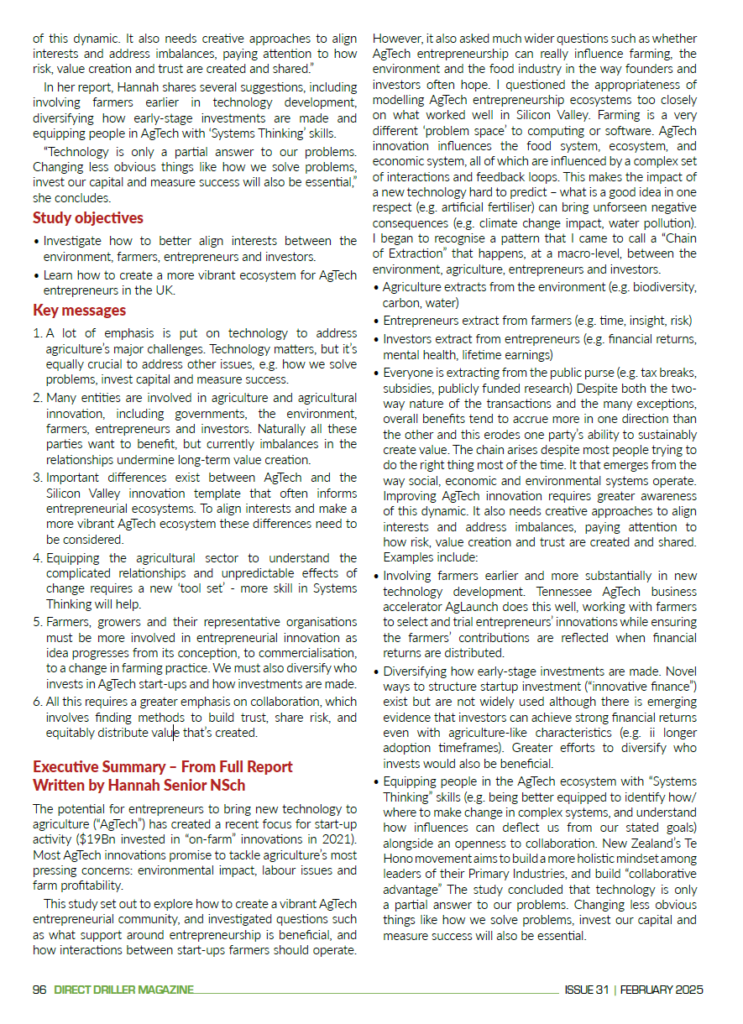Yorkshire entrepreneur Hannah Senior NSch has published her Nuffield Farming report ‘Innovating AgTech Entrepreneurship’, sponsored by the Elizabeth Creak Charitable Trust.
The full report is now published and available on the Nuffield Farming report library. A recording of Hannah presenting at the Nuffield Farming Conference watch via the QR Code.
During her Scholarship, Hannah travelled to New Zealand, Australia and the United States, in addition to conducting a number of visits in a further 11 countries via video call due to travel restrictions during the COVID-19 pandemic.
Hannah wanted to learn how to create a more vibrant ecosystem for AgTech entrepreneurs in the UK, understand beneficial support around entrepreneurship and how interactions between start-ups and farmers should operate.
In her report Hannah found that it was inappropriate to model AgTech entrepreneurship ecosystems on those found in Silicon Valley.
“Farming is a very different ‘problem space’ to computing or software,” she says. “AgTech innovation influences the food system, ecosystem and economic system, all of which are influenced by a complex set of interactions and feedback loops. This makes the impact of a new technology hard to predict.”
She identified a pattern which she named the ‘Chain of Extraction’ that happens at macro-level between the environment, agriculture, entrepreneurs and investors. “Despite both the two-way nature of the transactions and the many exceptions, overall benefits tend to accrue more in one direction than the other and this erodes one party’s ability to sustainably create value.

“Improving AgTech innovation requires greater awareness of this dynamic. It also needs creative approaches to align interests and address imbalances, paying attention to how risk, value creation and trust are created and shared.”
In her report, Hannah shares several suggestions, including involving farmers earlier in technology development, diversifying how early-stage investments are made and equipping people in AgTech with ‘Systems Thinking’ skills.
“Technology is only a partial answer to our problems. Changing less obvious things like how we solve problems, invest our capital and measure success will also be essential,” she concludes.
Study objectives
- Investigate how to better align interests between the environment, farmers, entrepreneurs and investors.
- Learn how to create a more vibrant ecosystem for AgTech entrepreneurs in the UK.
Key messages
- A lot of emphasis is put on technology to address agriculture’s major challenges. Technology matters, but it’s equally crucial to address other issues, e.g. how we solve problems, invest capital and measure success.
- Many entities are involved in agriculture and agricultural innovation, including governments, the environment, farmers, entrepreneurs and investors. Naturally all these parties want to benefit, but currently imbalances in the relationships undermine long-term value creation.
- Important differences exist between AgTech and the Silicon Valley innovation template that often informs entrepreneurial ecosystems. To align interests and make a more vibrant AgTech ecosystem these differences need to be considered.
- Equipping the agricultural sector to understand the complicated relationships and unpredictable effects of change requires a new ‘tool set’ – more skill in Systems Thinking will help.
- Farmers, growers and their representative organisations must be more involved in entrepreneurial innovation as idea progresses from its conception, to commercialisation, to a change in farming practice. We must also diversify who invests in AgTech start-ups and how investments are made.
- All this requires a greater emphasis on collaboration, which involves finding methods to build trust, share risk, and equitably distribute value that’s created.
Executive Summary – From Full Report
Written by Hannah Senior NSch
The potential for entrepreneurs to bring new technology to agriculture (“AgTech”) has created a recent focus for start-up activity ($19Bn invested in “on-farm” innovations in 2021). Most AgTech innovations promise to tackle agriculture’s most pressing concerns: environmental impact, labour issues and farm profitability.
This study set out to explore how to create a vibrant AgTech entrepreneurial community, and investigated questions such as what support around entrepreneurship is beneficial, and how interactions between start-ups farmers should operate. However, it also asked much wider questions such as whether AgTech entrepreneurship can really influence farming, the environment and the food industry in the way founders and investors often hope. I questioned the appropriateness of modelling AgTech entrepreneurship ecosystems too closely on what worked well in Silicon Valley. Farming is a very different ‘problem space’ to computing or software. AgTech innovation influences the food system, ecosystem, and economic system, all of which are influenced by a complex set of interactions and feedback loops. This makes the impact of a new technology hard to predict – what is a good idea in one respect (e.g. artificial fertiliser) can bring unforseen negative consequences (e.g. climate change impact, water pollution). I began to recognise a pattern that I came to call a “Chain of Extraction” that happens, at a macro-level, between the environment, agriculture, entrepreneurs and investors. • Agriculture extracts from the environment (e.g. biodiversity, carbon, water) • Entrepreneurs extract from farmers (e.g. time, insight, risk) • Investors extract from entrepreneurs (e.g. financial returns, mental health, lifetime earnings) • Everyone is extracting from the public purse (e.g. tax breaks, subsidies, publicly funded research) Despite both the two-way nature of the transactions and the many exceptions, overall benefits tend to accrue more in one direction than the other and this erodes one party’s ability to sustainably create value. The chain arises despite most people trying to do the right thing most of the time. It that emerges from the way social, economic and environmental systems operate. Improving AgTech innovation requires greater awareness of this dynamic. It also needs creative approaches to align interests and address imbalances, paying attention to how risk, value creation and trust are created and shared. Examples include: • Involving farmers earlier and more substantially in new technology development. Tennessee AgTech business accelerator AgLaunch does this well, working with farmers to select and trial entrepreneurs’ innovations while ensuring the farmers’ contributions are reflected when financial returns are distributed. • Diversifying how early-stage investments are made. Novel ways to structure startup investment (“innovative finance”) exist but are not widely used although there is emerging evidence that investors can achieve strong financial returns even with agriculture-like characteristics (e.g. ii longer adoption timeframes). Greater efforts to diversify who invests would also be beneficial. • Equipping people in the AgTech ecosystem with “Systems Thinking” skills (e.g. being better equipped to identify how/where to make change in complex systems, and understand how influences can deflect us from our stated goals) alongside an openness to collaboration. New Zealand’s Te Hono movement aims to build a more holistic mindset among leaders of their Primary Industries, and build “collaborative advantage” The study concluded that technology is only a partial answer to our problems. Changing less obvious things like how we solve problems, invest our capital and measure success will also be essential.
Read the full report here: https://www.nuffieldscholar.org/sites/default/files/2025-02/Hannah%20Senior%20final%20report%20pdf.pdf


